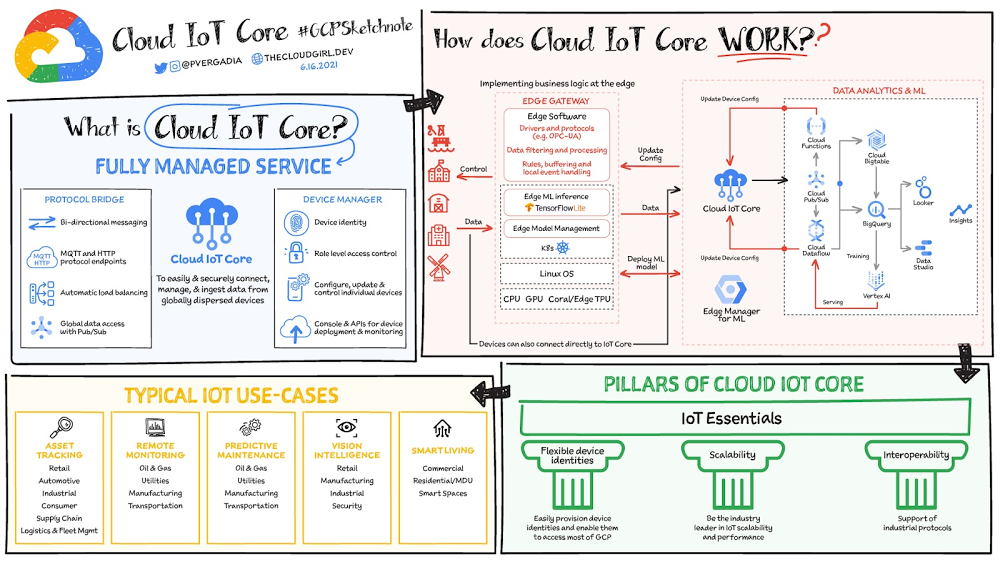Click to enlargeThe ability to gain real-time insights from IoT data can redefine competitiveness for businesses. Intelligence allows connected devices and assets to interact efficiently with applications and with human beings in an intuitive and non-disruptive way. After your IoT project is up and running, many devices will be producing lots of data. You need an efficient, scalable, affordable way to both manage those devices and handle all that information. IoT Core is a fully managed service for managing IoT devices. It supports registration, authentication, and authorization inside the Google Cloud resource hierarchy as well as device metadata stored in the cloud, and the ability to send device configuration from other GCP or third-party services to devices. Main componentsThe main components of Cloud IoT Core are the device manager and the protocol bridges:The device manager registers devices with the service, so you can then monitor and configure them. It provides:Device identity management Support for configuring, updating, and controlling individual devicesRole-level access controlConsole and APIs for device deployment and monitoringTwo protocol bridges (MQTT and HTTP) can be used by devices to connect to Google Cloud Platform for:Bi-directional messagingAutomatic load balancingGlobal data access with Pub/SubHow does Cloud IoT Core work?Device telemetry data is forwarded to a Cloud Pub/Subtopic, which can then be used to trigger Cloud Functions as well as other third-party apps to consume the data. You can also perform streaming analysis with Dataflow or custom analysis with your own subscribers.Cloud IoT Core supports direct device connections as well as gateway-based architectures. In both cases the real time state of the device and the operational data is ingested into Cloud IoT Core and the key and certificates at the edge are also managed by Cloud IoT Core. From Pub/Sub the raw input is fed into Dataflow for transformation, and the cleaned output is populated in Cloud Bigtable for real-time monitoring or BigQueryfor warehousing and machine learning. From BigQuery the data can be used for visualization in Looker orData Studio and it can be used in Vertex AI for creating machine learning models. The models created can be deployed at the edge using Edge Manager (in experimental phase). Device configuration updates or device commands can be triggered by Cloud Functions or Dataflow to Cloud IoT Core, which then updates the device. Design principles of Cloud IoT CoreAs a managed service to securely connect, manage, and ingest data from global device fleets, Cloud IoT COre is designed to be:Flexible, providing easy provisioning of device identities and enabling devices to access most of Google CloudIThe industry leader in IoT scalability and performance Interoperable, with supports for the most common industry-standard IoT protocolsUse casesIoT use cases range across numerous industries. Some typical examples include:Asset tracking, visual inspection, and quality control in retail, automotive, industrial, supply chain and logisticsRemote monitoring and predictive maintenance in oil & gas, utilities, manufacturing, and transportationConnected homes and consumer technologies.Vision intelligence in retail, security, manufacturing, and industrial sectorsSmart living in commercial, residential, and smart spaces Smart factories with predictive maintenance and real-time plant floor analytics For a more in-depth look into Cloud IoT Core check out the documentation. For more #GCPSketchnote, follow the GitHub repo. For similar cloud content follow me on Twitter @pvergadia and keep an eye out on thecloudgirl.dev.Related Article5 cheat sheets to help you get started on your Google Cloud journeyWhether you need to determine the best way to move to the cloud, or decide on the best storage option, we’ve built a number of cheat shee…Read Article
Quelle: Google Cloud Platform


Published by